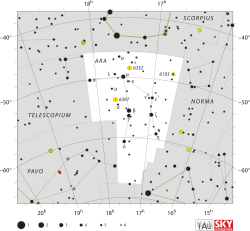Top Qs
Timeline
Chat
Perspective
V539 Arae
Triple star system in the constellation Ara From Wikipedia, the free encyclopedia
Remove ads
V539 Arae is a multiple star system in the southern constellation of Ara. It has the Bayer designation Nu1 Arae , which is Latinized from ν1 Arae and abbreviated Nu1 Ara or ν1 Ara. This is a variable star system, the brightness of which varies from magnitude 5.71 to 6.24, making it faintly visible to the naked eye under good observing conditions.[12] Based upon an annual parallax shift of 2.52 mas,[2] this system is at a distance of approximately 1,290 light-years (400 parsecs) from Earth. The system is drifting closer to the Sun with a radial velocity of −4 km/s.[5]

In 1930, Ferdinand Johannes Neubauer found that the star (usually called Boss 4496 at the time) is a spectroscopic binary. He did not detect any brightness variability.[14] Eclipses were first reported by E. Schoeffel and U. Kohler in 1965. The period they reported is 1/2 the currently accepted value, because they did not realize that the light curve has a deep secondary minimum.[15][16] In 1996, the secondary component was found to be a slowly pulsating B-type star (SPB) with periods of periods of 1.36, 1.78 and possibly 1.08 days.[17]
The core members of this system, ν1 Ara AB, consist of a pair of B-type main-sequence stars in a detached orbit with a period of 3.169 days and an eccentricity of 0.055.[7] Their respective stellar classifications are B2 V and B3 V, and they have a combined visual magnitude of 5.65. Because the orbital plane lies close to the line of sight from the Earth, this pair form a detached eclipsing binary of the Algol type.[11] The eclipse of the primary causes a decrease of 0.52 in magnitude, while the secondary eclipse decreases the magnitude by 0.43.[18]
At an angular separation of 12.34 arcseconds, is a possible tertiary component of this system; a magnitude 9.40 A-type main-sequence star with a classification of A1 V.[3] A 2005 study of the orbit of the main pair demonstrated an apsidal motion, suggesting the influence of a third body. The initial estimate found an orbital period of 42.3±0.8 years and a mass of 1.63 M☉.[7] In 2022, a more refined study suggested the influence of two stellar objects with masses of 0.41 M☉ and 1.74 M☉.[19]
The system is sometimes referred as Upsilon1 Arae (υ1 Arae), and more generally unlettered.[20]
Remove ads
References
External links
Wikiwand - on
Seamless Wikipedia browsing. On steroids.
Remove ads

